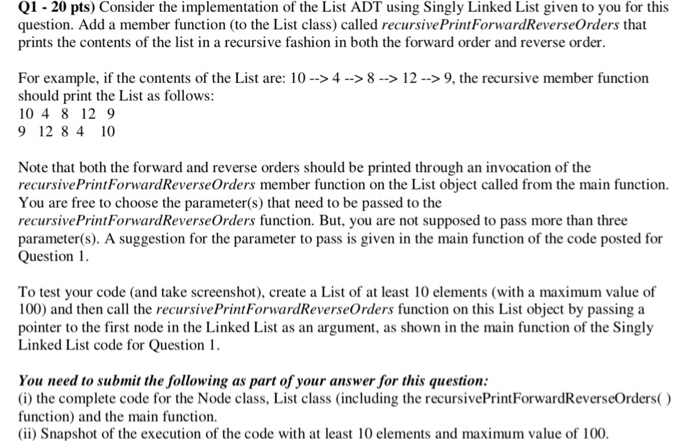Answered step by step
Verified Expert Solution
Question
1 Approved Answer
#include #include #include #include #include #include using namespace std; // implementing the dynamic List ADT using Linked List class Node{ private: int data; Node* nextNodePtr;

#include #include #include #include #include #include using namespace std; // implementing the dynamic List ADT using Linked List class Node{ private: int data; Node* nextNodePtr; public: Node(){} void setData(int d){ data = d; } int getData(){ return data; } void setNextNodePtr(Node* nodePtr){ nextNodePtr = nodePtr; } Node* getNextNodePtr(){ return nextNodePtr; } }; class List{ private: Node *headPtr; public: List(){ headPtr = new Node(); headPtr->setNextNodePtr(0); } Node* getHeadPtr(){ return headPtr; } bool isEmpty(){ if (headPtr->getNextNodePtr() == 0) return true; return false; } void insert(int data){ Node* currentNodePtr = headPtr->getNextNodePtr(); Node* prevNodePtr = headPtr; while (currentNodePtr != 0){ prevNodePtr = currentNodePtr; currentNodePtr = currentNodePtr->getNextNodePtr(); } Node* newNodePtr = new Node(); newNodePtr->setData(data); newNodePtr->setNextNodePtr(0); prevNodePtr->setNextNodePtr(newNodePtr); } void insertAtIndex(int insertIndex, int data){ Node* currentNodePtr = headPtr->getNextNodePtr(); Node* prevNodePtr = headPtr; int index = 0; while (currentNodePtr != 0){ if (index == insertIndex) break; prevNodePtr = currentNodePtr; currentNodePtr = currentNodePtr->getNextNodePtr(); index++; } Node* newNodePtr = new Node(); newNodePtr->setData(data); newNodePtr->setNextNodePtr(currentNodePtr); prevNodePtr->setNextNodePtr(newNodePtr); } int read(int readIndex){ Node* currentNodePtr = headPtr->getNextNodePtr(); Node* prevNodePtr = headPtr; int index = 0; while (currentNodePtr != 0){ if (index == readIndex) return currentNodePtr->getData(); prevNodePtr = currentNodePtr; currentNodePtr = currentNodePtr->getNextNodePtr(); index++; } return -1; // an invalid value indicating // index is out of range } void modifyElement(int modifyIndex, int data){ Node* currentNodePtr = headPtr->getNextNodePtr(); Node* prevNodePtr = headPtr; int index = 0; while (currentNodePtr != 0){ if (index == modifyIndex){ currentNodePtr->setData(data); return; } prevNodePtr = currentNodePtr; currentNodePtr = currentNodePtr->getNextNodePtr(); index++; } } void deleteElement(int deleteData){ Node* currentNodePtr = headPtr->getNextNodePtr(); Node* prevNodePtr = headPtr; Node* nextNodePtr = headPtr; while (currentNodePtr != 0){ if (currentNodePtr->getData() == deleteData){ nextNodePtr = currentNodePtr->getNextNodePtr(); break; } prevNodePtr = currentNodePtr; currentNodePtr = currentNodePtr->getNextNodePtr(); } prevNodePtr->setNextNodePtr(nextNodePtr); } void IterativePrint(){ Node* currentNodePtr = headPtr->getNextNodePtr(); while (currentNodePtr != 0){ cout getData() getNextNodePtr(); } cout > listSize; List integerList; // Create an empty list srand(time(NULL)); int maxValue; cout > maxValue; for (int i = 0; i getNextNodePtr(); integerList.recursivePrintForwardReverseOrders(firstNodePtr); return 0; } Step by Step Solution
There are 3 Steps involved in it
Step: 1

Get Instant Access to Expert-Tailored Solutions
See step-by-step solutions with expert insights and AI powered tools for academic success
Step: 2

Step: 3

Ace Your Homework with AI
Get the answers you need in no time with our AI-driven, step-by-step assistance
Get Started


